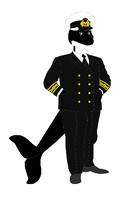
Daniel J. Morrell was built at West Bay City, Michigan, by the West Bay City Ship Building Company, for the Cambria Steamship Company, the Cambria Iron Company's marine subsidiary that they had formed earlier that year and launched on 22 August 1906. Cambria chartered both Daniel J. Morrell and her sister ship, Edward Y. Townsend, to sail for the M. A. Hanna Company, one of the most experienced vessel management firms on the lakes. In 1930, Daniel J. Morrell and Edward Y. Townsend came under management of the Bethlehem Transportation Company.
Making the last run of the season with Edward Y. Townsend, Daniel J. Morrell became caught in winds exceeding 70 mph (110 km/h) and swells that topped the height of the ship (20 to 25 ft (6.1 to 7.6 m) waves). During the early morning hours, Edward Y. Townsend made the decision to take shelter in the St. Clair River, leaving Daniel J. Morrell alone on the waters north of Pointe Aux Barques, Michigan, heading for the protection of Thunder Bay. At 02:00, the ship began her death throes, forcing the crew onto the deck, where many jumped to their deaths in the 34 °F (1 °C) Lake Huron waters. At 02:15, the ship's hull broke and allowed water to pour in, and the remaining crewmen loaded into a raft on the bow of the vessel. While they waited for the ship to break up and the raft to be thrown into the lake, there were shouts that a ship had been spotted off the port bow. Moments later, it was discovered that the looming object was not another ship, but Daniel J. Morrell's aft section, barreling towards them under the power of the ship's engine. The ship broke up, with the rafts continuing into the distance. In the words of writer William Ratigan, the remnants of the vessel disappeared into the darkness "like a great wounded beast with its head shot off".
Daniel J. Morrell was not reported missing until 12:15, the following afternoon, 30 November, after the vessel was overdue at her destination, Taconite Harbor, Minnesota. The U.S. Coast Guard issued a "be on the lookout" alert and dispatched several vessels and aircraft to search for the missing freighter.
At around 16:00, on 30 November, a Coast Guard helicopter located the lone survivor, 26-year-old Watchman Dennis Hale, near frozen and floating in a life raft with the bodies of three of his crewmates. Hale had survived the nearly 40-hour ordeal in frigid temperatures wearing only a pair of boxer shorts, a lifejacket, and a pea coat.
The survey of the wreck found the shipwreck in 220 ft (67 m) of water with the two sections 5 mi (8.0 km) apart.
Edward Y. Townsend, after having escaped the same fate as her sister, had been discovered as having a large crack in her deck that grew worse from the same storm, she was declared a total loss and was docked for almost two years. Plans were made to tow the vessel to Europe, to be scrapped. On her way during tow, she was caught in a strong storm on 7 October 1968, off Newfoundland and snapped in two, foundering in the general vicinity that Titanic had sunk. The German saltie Nordmeer, which had grounded at Thunder Bay Island Shoal on 19 November, was declared a total loss after the additional damage to its bottom caused by the storm.
The destructive force of the November seas and wind were an important factor in this loss, as it has been in many similar incidents on the Great Lakes. The Coast Guard investigation of the sinking of Daniel J. Morrell concluded that she broke in half due to the brittle steel used in her hull which was a "common problem" in ships built before 1948.
In addition to Edmund Fitzgerald, other contemporary Great Lakes freighters lost under similar circumstances were Carl D. Bradley and Henry Steinbrenner.
The following crew were lost in the sinking:
Bragg, Norman M., 40, Niagara Falls, New York, watchman
Campbell, Stuart A., 60, Marinette, Wisconsin, wheelsman
Cleary, John J. Jr., 20, Cleveland, Ohio, deckhand
Crawley, Arthur I., 47, Rocky River, Ohio, master
Dahl, George A., 38, Duluth, Minnesota, third assistant engineer
Davis, Larry G., 27, Toledo, Ohio, deckwatch
Fargo, Arthur S., 52, Ashtabula, Ohio, fireman
Fosbender, Charles H., 42, St. Clair, Michigan, wheelsman
Grippi, Saverio, 53, Ashtabula, Ohio, coal passer
Groh, John M., 21, Erie, Pennsylvania, deckwatch (missing)
Homick, Nicholas P., 35, Hudson, Pennsylvania, second cook
Kapets, Phillip E., 51, Ironwood, Michigan, first mate
Konieczka, Chester, 45, Hamburg, New York, fireman
MacLeod, Duncan R., 61, Gloucester, Massachusetts, second mate
Mahsem, Joseph A., 59, Duluth, Minnesota, porter
Marchildon, Valmour A., 43, Kenmore, New York, first assistant engineer
Marcotte, Ernest G., 62, Waterford, Michigan, third mate
Norkunas, Alfred G., 39, Superior, Wisconsin, second assistant engineer
Price, David L., 19, Cleveland, Ohio, coal passer
Rischmiller, Henry, 34, Williamsville, New York, wheelsman
Satlawa, Stanley J., 39, Buffalo, New York, steward (missing)
Schmidt, John H., 46, Toledo, Ohio, chief engineer
Sestakauskas, Charles J., 49, Buffalo, New York, porter
Simpson, Wilson E., 50, Albemarle, North Carolina, oiler
Stojek, Arthur E., 41, Buffalo, New York, deckhand
Truman, Leon R., 45, Toledo, Ohio, coal passer
Wieme, Albert P., 51, Knife River, Minnesota, watchman
Worcester, Donald E., 38, Columbia, Maine, oiler
Making the last run of the season with Edward Y. Townsend, Daniel J. Morrell became caught in winds exceeding 70 mph (110 km/h) and swells that topped the height of the ship (20 to 25 ft (6.1 to 7.6 m) waves). During the early morning hours, Edward Y. Townsend made the decision to take shelter in the St. Clair River, leaving Daniel J. Morrell alone on the waters north of Pointe Aux Barques, Michigan, heading for the protection of Thunder Bay. At 02:00, the ship began her death throes, forcing the crew onto the deck, where many jumped to their deaths in the 34 °F (1 °C) Lake Huron waters. At 02:15, the ship's hull broke and allowed water to pour in, and the remaining crewmen loaded into a raft on the bow of the vessel. While they waited for the ship to break up and the raft to be thrown into the lake, there were shouts that a ship had been spotted off the port bow. Moments later, it was discovered that the looming object was not another ship, but Daniel J. Morrell's aft section, barreling towards them under the power of the ship's engine. The ship broke up, with the rafts continuing into the distance. In the words of writer William Ratigan, the remnants of the vessel disappeared into the darkness "like a great wounded beast with its head shot off".
Daniel J. Morrell was not reported missing until 12:15, the following afternoon, 30 November, after the vessel was overdue at her destination, Taconite Harbor, Minnesota. The U.S. Coast Guard issued a "be on the lookout" alert and dispatched several vessels and aircraft to search for the missing freighter.
At around 16:00, on 30 November, a Coast Guard helicopter located the lone survivor, 26-year-old Watchman Dennis Hale, near frozen and floating in a life raft with the bodies of three of his crewmates. Hale had survived the nearly 40-hour ordeal in frigid temperatures wearing only a pair of boxer shorts, a lifejacket, and a pea coat.
The survey of the wreck found the shipwreck in 220 ft (67 m) of water with the two sections 5 mi (8.0 km) apart.
Edward Y. Townsend, after having escaped the same fate as her sister, had been discovered as having a large crack in her deck that grew worse from the same storm, she was declared a total loss and was docked for almost two years. Plans were made to tow the vessel to Europe, to be scrapped. On her way during tow, she was caught in a strong storm on 7 October 1968, off Newfoundland and snapped in two, foundering in the general vicinity that Titanic had sunk. The German saltie Nordmeer, which had grounded at Thunder Bay Island Shoal on 19 November, was declared a total loss after the additional damage to its bottom caused by the storm.
The destructive force of the November seas and wind were an important factor in this loss, as it has been in many similar incidents on the Great Lakes. The Coast Guard investigation of the sinking of Daniel J. Morrell concluded that she broke in half due to the brittle steel used in her hull which was a "common problem" in ships built before 1948.
In addition to Edmund Fitzgerald, other contemporary Great Lakes freighters lost under similar circumstances were Carl D. Bradley and Henry Steinbrenner.
The following crew were lost in the sinking:
Bragg, Norman M., 40, Niagara Falls, New York, watchman
Campbell, Stuart A., 60, Marinette, Wisconsin, wheelsman
Cleary, John J. Jr., 20, Cleveland, Ohio, deckhand
Crawley, Arthur I., 47, Rocky River, Ohio, master
Dahl, George A., 38, Duluth, Minnesota, third assistant engineer
Davis, Larry G., 27, Toledo, Ohio, deckwatch
Fargo, Arthur S., 52, Ashtabula, Ohio, fireman
Fosbender, Charles H., 42, St. Clair, Michigan, wheelsman
Grippi, Saverio, 53, Ashtabula, Ohio, coal passer
Groh, John M., 21, Erie, Pennsylvania, deckwatch (missing)
Homick, Nicholas P., 35, Hudson, Pennsylvania, second cook
Kapets, Phillip E., 51, Ironwood, Michigan, first mate
Konieczka, Chester, 45, Hamburg, New York, fireman
MacLeod, Duncan R., 61, Gloucester, Massachusetts, second mate
Mahsem, Joseph A., 59, Duluth, Minnesota, porter
Marchildon, Valmour A., 43, Kenmore, New York, first assistant engineer
Marcotte, Ernest G., 62, Waterford, Michigan, third mate
Norkunas, Alfred G., 39, Superior, Wisconsin, second assistant engineer
Price, David L., 19, Cleveland, Ohio, coal passer
Rischmiller, Henry, 34, Williamsville, New York, wheelsman
Satlawa, Stanley J., 39, Buffalo, New York, steward (missing)
Schmidt, John H., 46, Toledo, Ohio, chief engineer
Sestakauskas, Charles J., 49, Buffalo, New York, porter
Simpson, Wilson E., 50, Albemarle, North Carolina, oiler
Stojek, Arthur E., 41, Buffalo, New York, deckhand
Truman, Leon R., 45, Toledo, Ohio, coal passer
Wieme, Albert P., 51, Knife River, Minnesota, watchman
Worcester, Donald E., 38, Columbia, Maine, oiler
Category Artwork (Digital) / Miscellaneous
Species Sea Vehicle
Size 2500 x 1200px
File Size 501.5 kB
Listed in Folders
I actually had the pleasure to meet the sole survivor of the SS Daniel J Morrel, Dennis Hale. My father and I had heard he was doing a book signing and also recounting the tale of his survival at some place near Port Austin, MI - not far from where the ship had sunk just off the coast. While I sadly don't remember much of that meeting with him we talked for a few brief moments and shook hands. I was sad to hear when he passed away in September of 2015. I still believe I have the book he signed as well somewhere back home. If anyone would like to know which book it is I'd be more than happy to link it to those interested.

 FA+
FA+










Comments